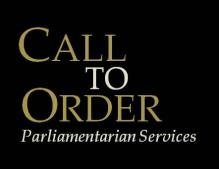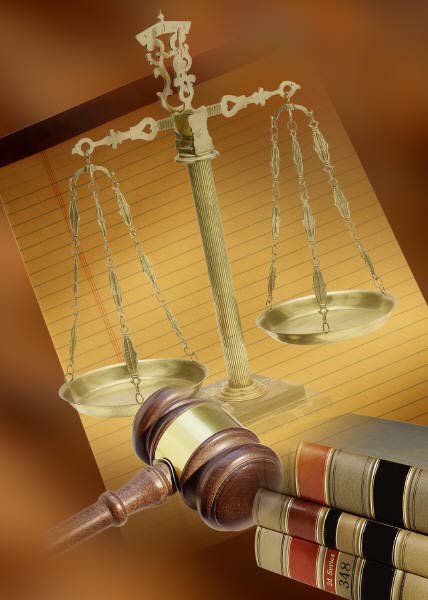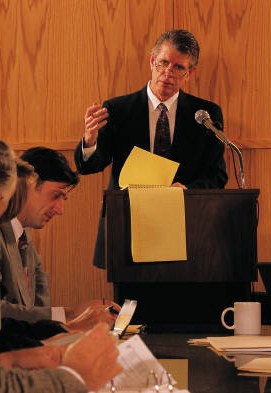In Mr. Smith Goes to Washington, the naïve Mr. Smith yields the Senate floor out of courtesy to a colleague, In doing so he loses his ability to debate on his legislation to prevent graft and corruption, Mr. Smith learned the hard way about the importance of knowing procedural rules. Officers and members of boards and and associations need to know the rules of order to achieve their goals and help their enterprises succeed. Our expertise includes:
- Meeting and Session Governance Services
- Presiding Officer Services
- Delegate Convention or Assembly Services
- Strategic Procedural Planning Services
- Bylaw Drafting, Review, and Revision Services
- Written Opinions Services
- Training Programs
Elements of bylaws
The bylaws of an organization are one part of the set of documents that establish an organization. Bylaws rank just under legal authorities for a corporate charter for an incorporated society in authority and should contain the basic governance structure of an organization. Section 56 of Robert's Rules of Order, Newly Revised, 11th ed. ("Robert's Rules") contains a significant discussion of bylaws including how to draft and adopt them as well as their content and rules for interpretation.
On the question of what should bylaws contain, the rule of thumb should be only those items that should be difficult to change or amend. Amendments to bylaws should be difficult to avoid frequent changes because of the whims of the occasion. So only those items that require stability and security from agenda-driven changes should be placed in the bylaws. Items such as membership, meetings, notices for meetings, officers and terms of office, and committees ought to be placed in bylaws. Locations, start times of meetings, agendas, limits on debate should all have a certain amount of flexibility and, therefore, should not be included in bylaws.
Specific elements include those already mentioned. In addition to membership, meetings, notices for meetings, officers and terms of office, and committees, the bylaws should also include and begin with name of the organization, its object, then members, officers, meetings, executive committee, committees, parliamentary authority, and finally, a process for amending the bylaws. While some of these items are pretty straight forward as to specifications, others require detailed descriptions. For example, membership may not require much description, but when assets are involved and where membership means being partial owner of the assets, detail as to membership shares, transfers, and voting rights all must be described. Officers also require careful consideration of many factors such as elections, terms of office, term limits, and powers and duties.
Finally, bylaws need not be limited to these topics, but these are fundamental to most associations. Additional topics may include disciplinary procedures, national versus a local affiliates and the relationship between the two. It's always a good idea to have a parliamentarian on hand who is familiar with the types of specifications of these items to assist in drafting, reviewing, or revising. Regardless, bylaws should be reviewed periodically to determine whether circumstances have changed to a degree that requirement amendments or revisions.
Bylaw Revisions
A revision of the bylaws is distinct from an amendment to the bylaws in that there is more than just a simple change or two to the existing bylaws. Typically a revision encompasses all of the bylaws and seeks to update and revise the entire document. Often times this can entail a significant amount material for members to digest and, therefore, requires a significant amount of time before final consideration and debate can take place.
Once the bylaws committee has completed its work and has produced a bylaw revision, it's a good idea to distribute to members for their review well in advance of the meeting at which the revision will be taken up. Unless circumstances won't permit, members should be given at least two or three months, and possibly more given the size of the organization and the complexity of the bylaws and the revisions.
The Chairman should set forth a schedule for review including a period during which amendments may be offered and a period for distribution of amendments for members to review. This should allow members to be prepared for the meeting at which the revision is taken up. At that meeting, the Chairman should have technology available to allow amendments to be seen by all in an amendment booklet or on-screen projection of the revisions and amendments.
Above all, a special rule should be established for debate and consideration of the revision. Typically such a special rule would establish an overall limit to debate and strictly limit debate on each amendment. It should further provide for consideration by seriatim or consideration by paragraph. Each pagraph is debated and amended without taking a vote until after all paragraph's have been considered. The Chairman then gives one final opportunity for debate or amendment of the entire document. When no other debate is forthcoming, the Chairman puts the question on adoption of the bylaws to a vote.
Provisos for Adopting Bylaws
When an oraganization is being formed and needs to adopt bylaws or when a longstanding organization seeks to adopt a full revision of the bylaws, certain provisions need to be established as a one-time item or of a short term duration. These are called provisos. While provisos are closely related to the bylaws, because of their limited applicability, they should not be included in the bylaws.
For example, an organization may desire to have committees with staggered terms to maintain continuity on the committee. That is, for a three member committee whose terms are for three years, the bylaws may require that only one member be elected or appointed in any given year. Initially, then, for a new set of bylaws or a full revision of an outdated set of bylaws, a rule must be established to initiate the staggering, such as, "one member shall serve for one year, one member shall serve for two years, and the third member shall serve a three-year term." When the one-year term is over, the successor shall serve for the full three-year term, and when the two-year term is over, the successor shall serve for three years also. In this way, the three-year staggered terms then become established.
Bylaws should not contain such an article or section, but this item is neccessary to successfully accomplish the desire to have three-year staggered terms. Therefore, when the bylaws or revisions are considered for adoption, as a part of the motion to adopt, a provision should be offered along with the bylaws, but outside of the bylaws to stagger the initial terms, but once those initial terms are complete the terms established in the bylaws then come into effect.
The possible applications of provisos in the adoption or revision of bylaws are considerable, but are very useful in accomplishing the purposes of the organization and its byaws without cluttering the bylaws with short-term provisions.
Following these procdures ought to provide for as smooth a process as could be expected in what is typically a formidable task!

© 2011-2012 Call to Order Parlimentarian Service
Bylaws: elements, revisions, and provisos


